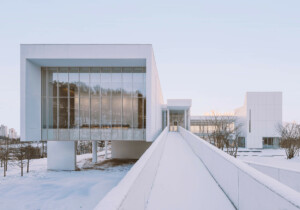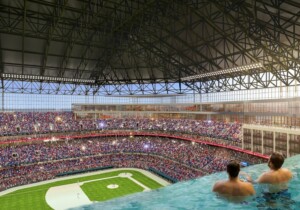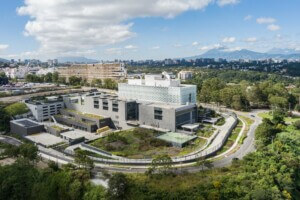In a district slated for redevelopment in Naju City, five miles south of Gwangju in southern South Korea, a vacant building scheduled for demolition is the site of a temporary architectural facade installation that minimizes the separation between interior and exterior. German and Korean–based architecture firm Hyunje Joo_Baukunst designed a cladding system that tiles 1,500 semi-transparent plastic baskets covering over 4,000 square feet of building envelope. The resulting effect is a translucent hazy skin that allows diffuse sunlight and silhouettes to seep into the interior.
- Facade Manufacturer
Dongam E&C - Architects
Hyunje Joo_Baukunst - Facade Installer
Munhyung Lee, with Lee Seok-hee, Sang Ho Lee, and Yoon Sangbo - Facade Consultants
n/a - Location
Naju-si, South Korea - Date of Completion
2017 - System
brise-soleil screen attached to existing structure - Products
UV-coated HDPE baskets, steel cable wire, steel frame
The baskets, relatively standard commercially-sold products, were manufactured by a Korean factory from high-density polyethylene (HDPE). For this project, the baskets were UV coated to ensure durability throughout the installation. HDPE is a common plastic material used in everything from rigid containers and hard hats to flexible bags and house wraps. It is a widely recycled material, and the architects intend to reuse the individual baskets upon dismantling the installation.
Hyunje Joo, the artist-architect responsible for the project, installed a steel subframe to the existing building facade and connected individual baskets to this frame using steel cable ties. Joo said the intent was to create an economical, flexible, light, and recyclable architectural element. “The surface minimizes the separation between the inside and outside, as light and silhouettes beyond the space show through. Over the course of the day, changes show on the surface of the wall due to the diffusion and reflection of the material. The passage of time is more actively sensed from both inside and outside, as these light effects stimulate our senses.”
Naju City, the site of the project, was designated an “Innovative City” in 2007, and since has seen ecologically sensitive development attracting several public offices from Seoul.
Despite the temporariness of the installation, the visual and spatial effects achieved with a three-dimensional semi-transparent perforated material are noteworthy and the architects say the success of this project will be carried on through future projects. “We intend to reinterpret the possibility for the boundary of the wall using new materials,” they said.










